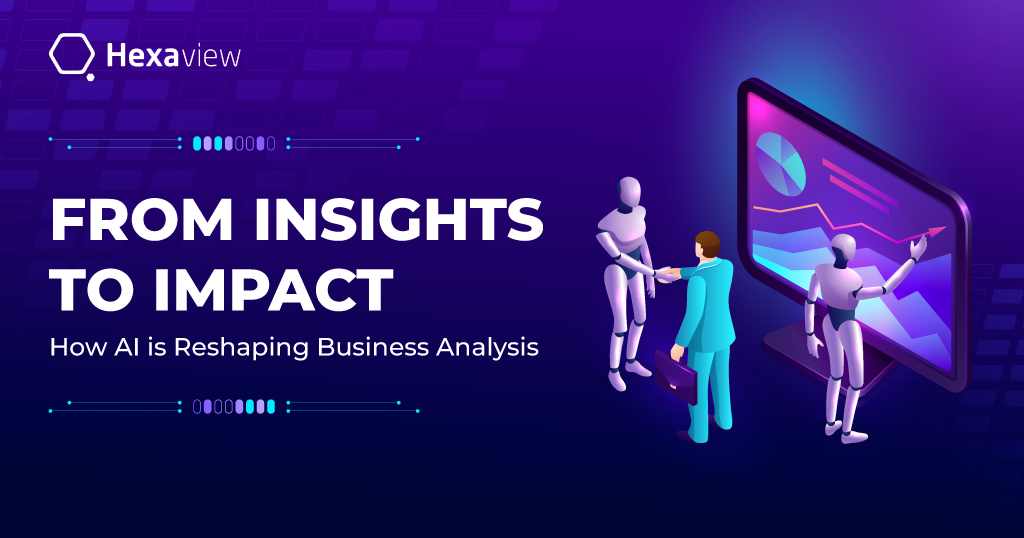General Published on: Wed Aug 20 2025



In today’s rapidly evolving business landscape, the role of Business Analysts (BAs) is expanding beyond traditional boundaries. Once focused primarily on requirement gathering, stakeholder communication, and process documentation, BAs are now expected to be strategic contributors who help shape decisions backed by data and technology.
One of the most transformative forces in this evolution is Artificial Intelligence (AI). With its ability to automate tasks, identify trends, and generate insights from vast amounts of data, AI is redefining how BAs approach their work across industries—from finance and IT to marketing and commerce.
This blog explores how Business Analysts can integrate AI tools and techniques to improve efficiency, deliver better insights, and remain competitive in an increasingly data-driven world.
Recent studies show that by 2027, AI is expected to automate up to 50% of data analysis tasks traditionally performed by humans, fundamentally changing how Business Analysts operate. This rapid shift calls for BAs to embrace AI not just as a tool, but as a strategic partner in driving business success.
The Evolving Role of a Business Analyst
Traditionally, BAs served as liaisons between business units and technical teams. Their work revolved around gathering requirements, creating process flows, and ensuring stakeholder needs were accurately translated into functional specifications.
However, as digital transformation accelerates, organizations are looking to BAs to take on more strategic roles. The shift is clear:
- From documenting to analysing: BAs are now expected to interpret data trends and provide actionable insights.
- From reactive to proactive: They must anticipate business needs and recommend improvements before issues arise.
- From support role to strategic partner: BAs collaborate more closely with C-level leaders and data science teams.
This evolution demands that BAs become comfortable with emerging technologies, particularly AI, to stay effective and relevant.
What AI Brings to the Table for Business Analysts
Understanding AI in a Business Context
At its core, AI refers to machines or software systems that mimic human intelligence—learning from data, recognizing patterns, and making decisions. For Business Analysts, AI serves as a powerful extension of their capabilities.
Key AI Technologies Useful to BAs
- Machine Learning (ML): Enables systems to learn from data and improve over time without being explicitly programmed.
- Natural Language Processing (NLP): Allows machines to understand and process human language—useful for summarizing stakeholder interviews or analysing survey responses.
- Predictive Analytics: Helps forecast trends and outcomes based on historical data, supporting strategic planning.
- Robotic Process Automation (RPA): Automates routine, rules-based tasks such as data entry and reporting.
- Generative AI: Tools like ChatGPT can help draft documentation, create user stories, or ideate business solutions quickly.
The integration of these technologies empowers BAs to analyse more data, automate tedious tasks, and contribute meaningfully to strategic discussions.
Expanding the Role: Shaping AI Strategy
Beyond using AI tools, BAs can play a crucial role in shaping AI strategy within their organizations. For example, BAs can:
- Identify business areas where AI can generate the most value, guiding prioritization of AI initiatives.
- Collaborate with data scientists to define key performance indicators (KPIs) for AI models ensuring alignment with business goals.
- Lead ethical AI adoption by advocating for transparency, fairness, and compliance in AI-powered decision-making processes.
- Develop feedback loops between business units and AI teams to continuously refine AI applications based on real-world impact.
Key Use Cases: How Business Analysts Can Use AI
-
Data Analysis and Pattern Recognition
AI tools can quickly analyse large datasets, uncovering insights that would take days to find manually. For example, a BA in the retail sector might use ML models to analyse shopping patterns and identify opportunities for cross-selling or dynamic pricing.
-
Enhanced Forecasting and Predictive Modelling
In the finance industry, predictive models can help BAs estimate credit risks or forecast loan defaults. This enables proactive decision-making and more accurate risk assessments.
-
Requirement Gathering and Documentation
NLP tools can automatically summarize interview transcripts and stakeholder feedback. Generative AI can assist in drafting business requirement documents (BRDs), use cases, or functional specs—accelerating the documentation process and improving consistency.
-
Process Optimization and Automation
RPA bots are widely used to automate tasks such as invoice processing or data reconciliation. In accounting, for instance, a BA can identify repetitive tasks that bots can handle, allowing teams to focus on more strategic activities.
-
Decision Support and Strategic Insights
AI-powered dashboards deliver real-time metrics and highlight anomalies. In marketing, a BA might use predictive analytics to assess campaign performance or simulate outcomes before launching new strategies.
Transforming Analysis with AI: Voices of Innovation and Real-Life Testimonials
Working on a smart retail initiative, I used computer vision and ML analytics to study in-store customer movement. With AI-generated heat maps and traffic patterns, we redesigned product placements—boosting impulse sales by 12%. It was a tangible win driven by data.”
— Meera Joshi, Business Analyst, Retail Chain
“We integrated ChatGPT into our internal documentation processes, and it completely redefined team productivity. Drafting BRDs, meeting summaries, and stakeholder Q&As became faster and more consistent. What’s more, junior BAs could ramp up quickly using AI as a support partner.”
— Kyle Thompson, Lead BA, IT Consultancy Firm
“By combining AI sentiment analysis with customer support transcripts, we discovered recurring frustration themes we hadn’t picked up in CSAT scores. This insight directly influenced UX design changes that led to a 25% increase in app satisfaction ratings.”
— Ritika Sharma, BA – Digital Experience, FinTech Startup
Industry Based Examples and Case Studies
- Retail Industry: A leading online retailer used AI-based customer segmentation to tailor product recommendations. The BA involved worked closely with data scientists to interpret insights and redesign the customer journey—resulting in a 20% boost in conversion.
- Banking Sector: A financial institution applied predictive modelling to identify early signs of loan default. The BA used this information to improve risk assessment protocols, helping reduce non-performing assets.
- Consulting Firm: A BA team deployed ChatGPT to draft stakeholder meeting summaries and project documentation. The result? A 40% reduction in admin time and improved clarity in client communication.
Tools and Platforms Empowering AI for BAs
Dashboards & Data Visualization Tools
- Microsoft Power BI Sample Reports
Explore community-created dashboards to understand real-world business use cases powered by AI-driven insights. - Qlik Sense Demo Hub
Interactive demos across industries like healthcare, retail, and supply chain with embedded predictive analytics. - Looker Studio (formerly Google Data Studio)
Access a gallery of public dashboards showcasing AI-powered data reporting and visualization. - Tableau (with Explain Data): For visual storytelling and anomaly detection.
- Power BI (with Copilot): Allows natural language queries and automated insights.
Robotic Process Automation (RPA)
- UiPath Academy
Free RPA training with hands-on labs and certifications. Ideal for BAs learning how to automate tasks. - Automation Anywhere Community Edition
Try RPA workflows firsthand using Automation Any where's free tier. - Blue Prism Digital Exchange (DX)
Browse pre-built AI and automation components you can plug into workflows—great for idea generation.
AI Simulation & Forecasting Tools
- TIBCO Spotfire Free Trial
Explore AI-driven forecasting, anomaly detection, and what-if simulations. - Anaplan Demo Hub
Try predictive modelling and scenario planning in a finance or operations context.
Natural Language Processing & Generative AI Tools
- ChatGPT by OpenAI
Use it for summarizing interviews, drafting user stories, or brainstorming solution ideas. - MonkeyLearn
Try real-time NLP tools for sentiment analysis, keyword extraction, and topic classification using business data. - Hugging Face Spaces
Explore interactive NLP and ML apps built by the AI community. Many demos are no-code and BA-friendly.
Low-Code/No-Code Platforms
Many platforms now offer AI capabilities with minimal technical complexity, making it easier for BAs without a programming background to implement AI solutions and contribute to digital transformation projects.
- Microsoft Power Platform AI Builder
Use AI to enhance Power Apps or Power Automate flows with minimal coding. - Google Vertex AI Studio (No-Code AI Prototyping)
Prototype and test LLMs, classification models, or image recognition tools in a low-code interface. - IBM Watson Studio Free Tier
Experiment with AutoAI, visual model building, and NLP without needing deep data science skills.
Overcoming Challenges in Adopting AI
Despite the benefits, AI adoption doesn’t come without challenges:
- Data privacy concerns: BAs must ensure compliance with regulations like GDPR or CCPA when handling sensitive data.
- Skill gaps: Many BAs need to develop AI literacy to fully utilize these tools.
- Resistance to change: Teams may be hesitant to trust automated systems over human expertise.
- Over-dependence on AI: While AI supports analysis, human judgment remains crucial for contextual understanding.
Overcoming these hurdles requires a balanced approach—adopting AI gradually, while investing in continuous learning and change management
Building AI Literacy as a Business Analyst
To stay competitive, BAs should focus on upskilling:
- Enrol in AI and data analytics courses on learning platforms.
- Participate in AI-enabled projects across departments.
- Attend industry conferences and network with data professionals.
- Follow case studies relevant to their industry to understand real-world applications.
Even a basic understanding of how models work, what data is required, and how outputs are interpreted can significantly enhance a BA’s effectiveness.
Outlook: The AI-Enabled Business Analyst
Looking ahead, the lines between Business Analyst, Data Analyst, and AI Product Manager are beginning to blur. As AI becomes more integrated into business workflows, hybrid roles will become the norm.
What won’t change is the importance of human insight. AI might do the number crunching, but it’s the BA who frames the right questions, understands business context, and communicates findings effectively.
Kickstart Your AI Journey: Essential Steps & Resources for Business Analysts
Ready to start your AI journey as a Business Analyst? Here are some steps and resources to explore:
Courses:
- Coursera – “AI For Everyone” by Andrew Ng: an expert-led foundational course for non-technical professionals looking to understand AI's impact.
🔗 https://www.coursera.org/learn/ai-for-everyone - LinkedIn Learning – “Business Analytics Foundations”: a great starter course covering descriptive and exploratory analytics. (linkedin.com)
🔗 https://www.linkedin.com/learning/business-analytics-foundations
Communities:
- IIBA – AI Special Interest Group: engage with global business analysis professionals exploring AI adoption in BAs.
Blogs and Publications:
- Towards Data Science: a popular medium publication with a range of AI/data articles (quality varies). (linkedin.com, reddit.com)
🔗 https://towardsdatascience.com - BA Times: a leading source for business analysis news and trends.
🔗 https://www.batimes.com
Projects:
- Kaggle or GitHub can help host datasets and project code.
🔗 https://www.kaggle.com
Conclusion
AI isn’t just a buzzword—it’s a transformative tool that’s reshaping the Business Analysis profession. From enhancing data interpretation to automating repetitive tasks, AI gives BAs the leverage they need to deliver faster, smarter, and more impactful results.

Harshil Saini
How AI is Transforming Business Analysis
Transforming Business Analysis
















